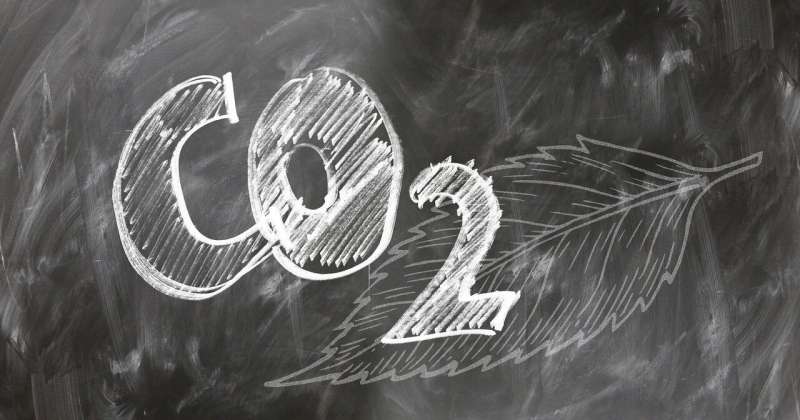This article has been reviewed according to Science X's editorial process and policies. Editors have highlighted the following attributes while ensuring the content's credibility:
fact-checked
trusted source
proofread
Graduates' activities produce more carbon dioxide and their ecological commitment is primarily symbolic, says research

Middle-class UK graduates produce more CO2 emissions in their daily activities than non-graduates and their ecological commitment is primarily "symbolic", new research says.
Dr. Robert Dorschel, of Tilburg University in The Netherlands, analyzed survey data on 12,763 people in 5,473 households in the UK who were asked to complete a diary of their activities.
Dr. Dorschel, who is also a research associate of the University of Cambridge, then looked at the middle class, defined as those earning between 0.7 and 2.5 times the average, dividing them into those with degrees and those without.
He found that those with a degree produced 9.76 tons a year and those without 9.49, a gap that can be accounted for by extra travel. By comparison the lower class, earning less than 0.7 times the average income, produced only 6.63 tons a year and were the most eco-friendly group.
Dr. Dorschel told the British Sociological Association's annual conference in Manchester that "even though their emissions are just as high or even higher, middle-class graduates reap the growing symbolic profit that comes with a presentation of the self as eco-friendly."
"But the distinction between them and middle-class non-graduates, as well as the lower class, must ultimately be considered as symbolic only."
Middle-class graduates produced less CO2 for their housing than middle-class non-graduates, but more for their travel and other mobility and consumption, he found.
The two groups were often at odds, he said, with the non-graduate middle class seeing graduates as 'unrooted selves' who had lost touch with the issues of normal people. Graduates thought the non-graduates were not progressive and were supporters of conservative and right wing parties.
Dr. Dorschel said that middle-class graduates moved around frequently for their careers, were more likely to work in cities than in the countryside, and tended to work in the knowledge economy and support center and left wing parties. Non-graduate middle-class people tended to be rooted in the region they were born, living in smaller towns and rural habitats and worked in traditional industry jobs, mid-level office and service occupations or in independent craftsmanship.
The survey required participants to record their activities over 14 days, from which an estimate of their yearly emissions was made. Dr. Dorschel divided the participants into an upper class, whose income was 250% (2.5 times) higher than the average, a lower class whose income was less than 70% of the average, and a remaining middle class.
The full figures were:
Upper class (the top 9.4%, earning more than 2.5 times the average amount): annual CO2 production—14.71 tons, of which 5.39 from consumption (food, holidays, recreation); 5.62 from mobility (cars, flights, public transport); and 3.69 from housing. In this group 77% were graduates.
Graduate middle class (30.4% of sample): annual CO2 production—9.76 tons, of which 3.46 from consumption; 3.53 from mobility; and 2.77 from housing.
Non-graduate middle class (33.6% of sample): annual CO2 production—9.49 tons, of which 3.40 from consumption; 3.03 from mobility; and 3.06 from housing.
Lower class (the lowest 26.5% of sample, earning less than 0.7 times the average amount) annual CO2 production—6.63 tons, of which 2.22 from consumption; 1.50 from mobility; and 2.91 from housing. In this group 27% were graduates.
Dr. Dorschel said his research had also demonstrated the gap in emissions between the most and least well-off.
"The upper class is pulling away not just economically but also in terms of their CO2 emissions. While the lower class is three tons of CO2 below the middle class, the upper class is six tons higher."
"The upper class has the combined CO2 emissions of the lower and middle class. The class with the most eco-friendly conduct of life is by far the lower class."
"Appeals to the middle and lower class to conduct a more sustainable way of life appear only justifiable if the upper class is also forced to reduce their CO2 emissions."
When calculating income, the researchers used the OECD equivalized system: the total gross income of all the members of the household is divided by a figure based on the number of people in the household, with a value of 1.0 given to the first adult, 0.5 to the second and each subsequent person aged 14 and over, and 0.3 to each child aged under 14. In this system the upper class income figure was £72,800; the middle-class graduates £28,500, and middle-class non-graduates, £23,400; the lower class £9,700. The UK Living Cost and Food survey collected the data in 2018-2019.
Provided by British Sociological Association





















